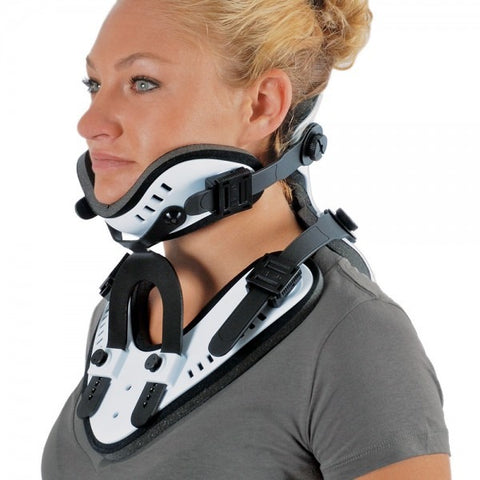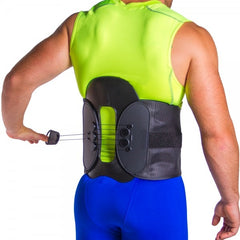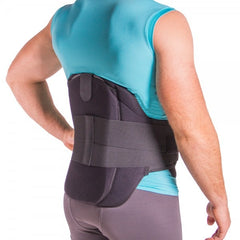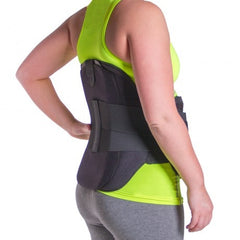Spondylosis
What Is Spondylosis?
You may have heard your doctor talk about the term spondylosis, which is a confusing condition to understand because the word is used in many different ways. On top of its assortment of meanings, the terms are often associated with words like spondylitis. The term “spondyl” is the Greek word for vertebrae. Because of this, in medicine, many different conditions relating to the spine begin with the word “spondyl” causing confusion. To begin addressing the meaning of spondylosis, it is a term that refers to degenerative changes in the spine by aging. This can be from a variety of problems ranging from bone spurs, degenerative disc, facet joint syndrome, and osteoarthritis. In essence, spondylosis is a general term describing any type of spinal degeneration. Words you hear associated with spondylosis are more direct conditions or clinical diagnosis occurring to the spine.
Spondylosis Umbrella of Conditions:
-
Osteoarthritis
-
Bone Spurs
To fully understand spondylosis (or the specific conditions falling under the umbrella of spondylosis), you must understand the anatomy of your spine. Your spine is made up of 24 individual bones that are stacked one on top of the other. To visualize the anatomy of your spine, separate it into three parts. The cervical spine is the neck portion, the thoracic spine covers the majority of your upper to mid back, and the lowest portion of your spine is referred to as the lumbar spine. This portion of your body is vital to your health as it supports the rest of your body. This means, without your spine, you wouldn’t be able to stand upright, bend, or twist.
Ankylosing Spondylosis? Not so Fast!
Many people have the misunderstanding that a condition of spondylosis ankylosing exists. However, as we touched on earlier, this confusion comes from the similarity in the words spondylosis and spondylitis. The actual name of the condition is spondylitis ankylosing. Unlike spondylosis, the catch-all term for spinal degeneration, spondylitis refers to the clinical diagnosis of inflammatory arthritis to the spine. This condition can affect the spine and any larger joints. In fact, overtime this inflammation can become so severe that eventually, your vertebrae could fuse together. Unfortunately for males, this condition is two to three times more likely to affect you. This condition is also known to be genetically inherited, so if you’re a man with family history of ankylosing spondylitis we highly recommend you take precautions. In fact, the HLA-B27 gene can be detected in the blood of most patients with the condition.
Ankylosing spondylitis is a form of chronic inflammation of the spine and sacroiliac joints. These joints are located at the base of the low back where the sacrum meets the iliac bones. You can see the inflammation that develops in the graphic comparing a normal spine and ankylosing spine below. Thankfully, if you catch and treat this condition early on you can likely relieve the pain and not cause permanent spinal deformities. However, people who have severe ankylosing spondylitis can over time grow a permanent spinal deformation. For example, into severe conditions like kyphosis.
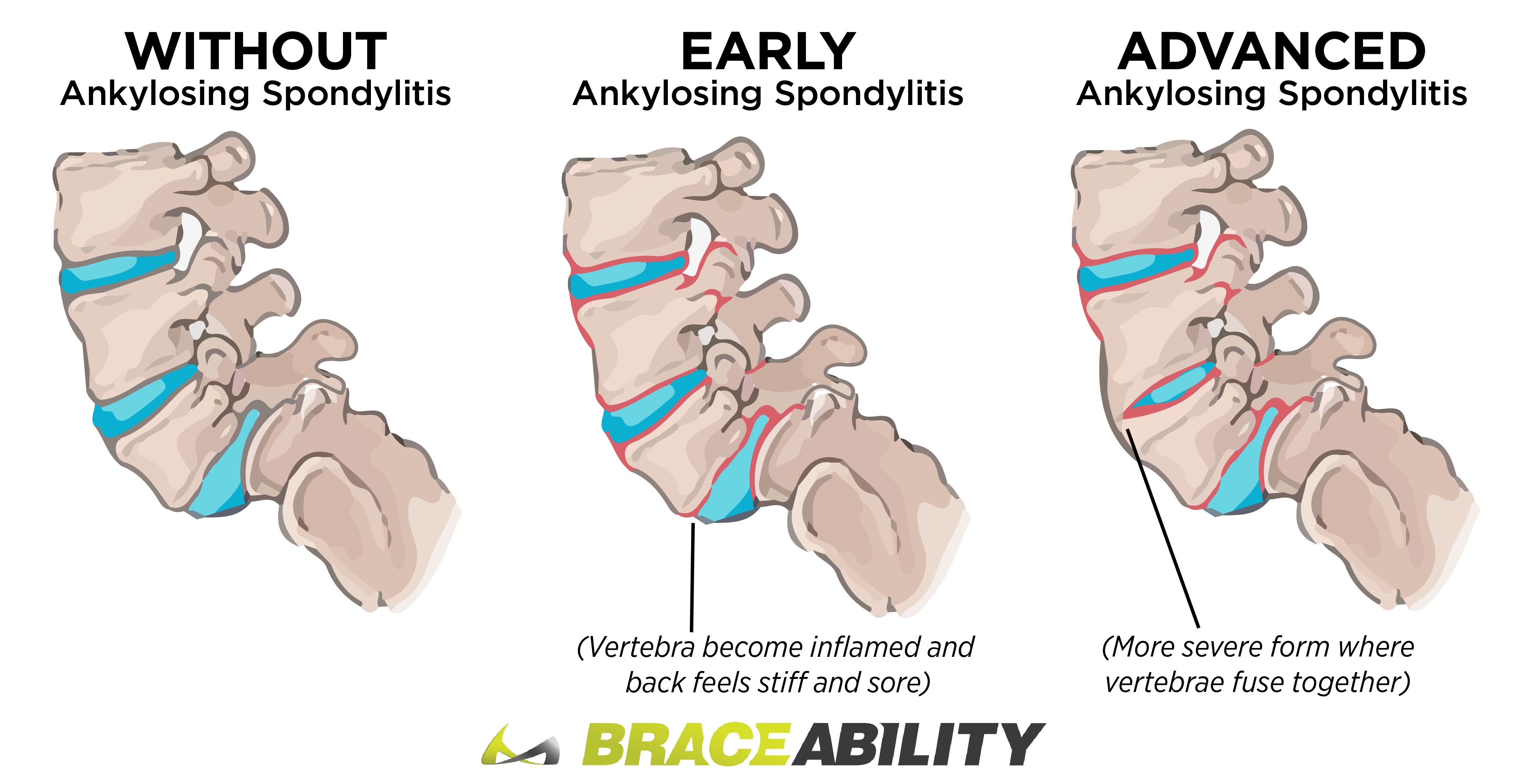
Symptoms of Ankylosing Spondylitis:
The early symptoms of ankylosing spondylitis include pain and stiffness in your lower back, specifically hips. You will likely experience this more in the morning and after any extended periods of inactivity. It’s not uncommon to experience things like neck pain and fatigue, which over time these symptoms will likely worsen. This condition will most likely be experienced in your joints between the base of the spine and your pelvis, as well as vertebrae in your lower back.
How do I Treat My Ankylosing Spondylitis?
There is no absolute cure for ankylosing spondylitis. However, there are many things you can do to reduce symptoms and help manage your pain. Often times people will be prescribed some form of anti-inflammatory medication to assist with the pain. Beyond medication, therapy is often used to treat and help with strength and flexibility. Using a range of motion exercises can help maintain flexibility in your joints and encourage good posture. In rare cases your doctor may talk to you about potential surgical options, however, this is fairly uncommon.
Cervical, Thoracic, Lumbar, and Multilevel Degenerative Spondylosis:
Spondylosis of the spine can occur in any portion of the spine, including the cervical, lumbar, and thoracic. As touched on earlier, cervical is the beginning portion of the spine at the neck, thoracic in the upper to middle back, and lumbar in the lower back. So depending on the location of the disc and joint degeneration, the name of your specific spondylosis will change. Most of these conditions are also referred to as cervical osteoarthritis, thoracic osteoarthritis, and lumbar osteoarthritis. However, just because we often refer to spondylosis in terms of cervical, thoracic, and lumbar, this doesn't mean it can't affect more than one. This type of spondylosis is known as multilevel degenerative spondylosis, meaning it's affecting more than one of the areas. This type of spondylosis is often more degenerative and advanced than the other forms. You may have your doctor refer to your condition as mild spondylosis. Essentially, this means your spondylosis is in the beginning stages of degeneration, rather than advanced spondylosis.
In the medical world, the terms bilateral and unilateral are often used. Unilateral means that the condition is happening on one side, while bilateral means that both sides are being affected. The terms unilateral and bilateral apply to spondylosis and are often used to describe the location of the spondylosis on the spine.
Cervical Spondylosis:
This form of spondylosis is also known as cervical osteoarthritis or neck arthritis. This is an age-related condition that affects the joints and discs in the neck. According to Mayo Clinic, the condition is present in more than 85 percent of people over the age of 60. Unfortunately, it’s common to experience side effects like dizziness and vertigo with cervical spondylosis.
Cervical Spondylosis With or Without Myelopathy:
Cervical spondylosis with myelopathy is also referred to as CSM. This condition refers to the impaired function of your spinal cord by degeneration. Because what happens to your spinal cord is caused by degeneration, it’s considered a type of spondylosis.
To understand myelopathy you must understand what your spinal cord is. Your spinal cord is the inner portion of your spine that is made up of bundles of fibers; it’s the main pathway of information from your brain to the rest of your body. Your brain and spinal cord together make up your central nervous system.
But it’s important to understand that your spine and your spinal cord are different. The spinal cord runs down from your brain, through a canal in the middle of the bones that make up your spine. Your spinal cord runs through your C1 vertebrae (your neck, or the top of your spine), all the way down through your T12 vertebrae (the end of your thoracic spine, or the top of your lower back).
Spondylosis with Radiculopathy:
You may be wondering, what is radiculopathy? Well, it’s similar to the term spondylosis in the sense that it’s a catch-all term, but radiculopathy is in reference to a pinched nerve. Radiculopathy occurs when a nerve in the spine is compressed or irritated at the point where it branches to the spinal cord. Any type of spinal degeneration can cause radiculopathy, hence why it's associated with spondylosis. The case of radiculopathy is the same as myelopathy. This condition can only occur in cervical and thoracic spondylosis as these are the locations of the spine where the spinal cord exists.
Spondylosis Causes:
The spine is a part of the human body that is very susceptible to problems, specifically as we age. A variety of things may have directly caused your specific spondylosis condition. However, it’s often related to general wear and tear from our daily lives.
What Happens to our Spines as we Age?
Over time through wear and tear on the body, our spines can begin to degenerate. This is especially true for women who are undergoing menopause. For example, the flexibility our spine provides us while we're young will naturally dry up throughout time. Losing the flexibility of your spine can become a major issue because those cushions act as shock absorbers for our spinal bones. This type of problem can lead to conditions such as bone spurs or weakened facet joints. Essentially, with time people begin to lose bone or vertebrae mass or density, meaning the bone has less calcium and other minerals. It’s this type of spinal change that is collectively called spondylosis.
Spondylosis Symptoms:
Spondylosis symptoms can vary greatly from person to person. In fact, many people won’t experience much for symptoms at all. However, it generally depends on what form of spondylosis condition you specifically have.
Cervical Spondylosis: Stiffness and pain in the neck
Osteoarthritis: Pain and stiffness throughout the spine, specifically in the morning
Bone Spurs: Dull neck, headaches, and numbness or tingling throughout the body
Degenerative Disc Disease: Lower back and neck pain, activity flare pain
Spinal Stenosis: Leg and lower back pain
Facet Joint Syndrome: Pain and numbness depending on location
Spondylosis Treatment:
There is no true cure to reverse the process of spondylosis. This is true because the condition is a degenerative process, meaning it irreversible and occurs mostly with age. However, there are many treatment options for pain relief when spondylosis is experienced in the neck, back, and spine.
Acupuncture: You may have heard of acupuncture in recent years as it's become a nonsurgical way to treat a multitude of body pains. In acupuncture, tiny needles are inserted into specific and targeted parts of the body. The location of these needles depends on the pain in which you are having treated. In the case of spondylosis, needles will most likely range between the cervical and the lumbar spine. Each of these individual needles may be twirled, electrically stimulated, or warmed. The theory behind acupuncture is that the tiny needles encourage the body to release chemicals that help with pain reduction.
Bed Rest: If you’re experiencing a very severe case of spondylosis your doctor may recommend some level of bed rest. Most often, bed rest is encouraged no longer than 3 days. Unfortunately, if bed rest is done for too long it may have reverse effects on the progress of your spondylosis.
Brace Use: Bracing can be a very useful tool in helping to relieve pain caused by spondylosis. However, it’s important similar to bed rest, braces aren’t worn for too long. Braces will help to target and isolate areas of pain to offer you some level of relief.
Physical Therapy: Physical therapy is a form of treatment that focuses on healing through massages, heat treatments, and exercises. This combination of treatment can be extremely helpful in pain relief for spondylosis. For example, a joint effort of heat and ultrasound treatment and exercises for strength and increased flexibility will commonly take away the chronic pain of back and neck problems.
Spinal Injections: If you’re experiencing a more severe case of spondylosis spinal injections may be your best option to find relief. However, we strongly recommend more mild attempts at relief before considering things such as injections and surgery. Most commonly injections will combine a local anesthetic and steroid medication to reduce inflamed nerve tissues, this will in return relieve pain.
Spondylosis Exercises: Performing exercises for your spondylosis can be very helpful in pain relief. Exercises can help to strengthen and stretch the affected areas which are important in the process of relief. Medical professionals recommend keeping your spine mobile in order to achieve a healthier spine.
Spondylosis Surgery: Surgery on spondylosis is extremely uncommon, but not unheard of. Thankfully, most cases of spondylosis never become severe enough for surgical options, or people experience enough relief through treatments like what is talked about above. In the case that surgery may be an option for you, the surgical procedure performed will be at your doctor's discretion. In some cases, the removal of bone spurs may be best for your specific case, or your physician may recommend a spinal fusion.

Spondylosis: The general term pertaining to degeneration of the spine including cervical, thoracic, and lumbar. This term is an umbrella term often pertaining to conditions like osteoarthritis, bone spurs, and degenerative disc disorder.
Spondylitis: The term referring to the form of arthritis that commonly occurs in the back. Ankylosing spondylitis refers to the inflammation of the joint in the spine, otherwise known as the sacroiliac joints (SI joints).
Spondylolisthesis: A specific condition in which the bones within your vertebra slide forward or backward over the bone next to it. This typically occurs at the fifth or fourth vertebra of the lower back.
Spondylolysis: A condition in which a defect or stress fractures occurs in the pars interarticularis of the vertebral arch. The most common form of this condition is the L5 spondylolysis, followed by spondylolysis of the fourth vertebrae.



